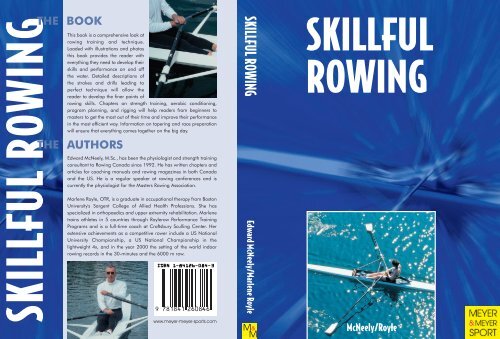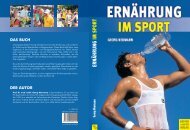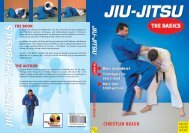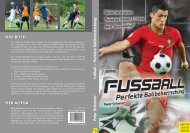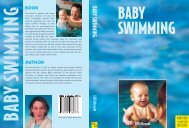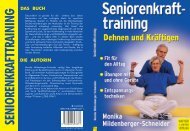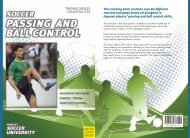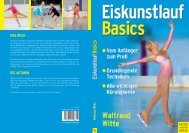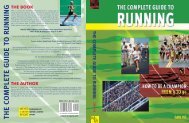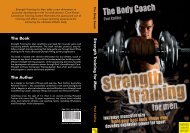Skillful Rowing_engl.
Skillful Rowing_engl.
Skillful Rowing_engl.
Create successful ePaper yourself
Turn your PDF publications into a flip-book with our unique Google optimized e-Paper software.
This book is a comprehensive look at<br />
rowing training and technique.<br />
Loaded with illustrations and photos<br />
this book provides the reader with<br />
everything they need to develop their<br />
skills and performance on and off<br />
the water. Detailed descriptions of<br />
the strokes and drills leading to<br />
perfect technique will allow the<br />
reader to develop the finer points of<br />
rowing skills. Chapters on strength training, aerobic conditioning,<br />
program planning, and rigging will help readers from beginners to<br />
masters to get the most out of their time and improve their performance<br />
in the most efficient way. Information on tapering and race preparation<br />
will ensure that everything comes together on the big day.<br />
THE AUTHORS<br />
Edward McNeely, M.Sc., has been the physiologist and strength training<br />
consultant to <strong>Rowing</strong> Canada since 1992. He has written chapters and<br />
articles for coaching manuals and rowing magazines in both Canada<br />
and the US. He is a regular speaker at rowing conferences and is<br />
currently the physiologist for the Masters <strong>Rowing</strong> Association.<br />
Marlene Royle, OTR, is a graduate in occupational therapy from Boston<br />
University's Sargent College of Allied Health Professions. She has<br />
specialized in orthopaedics and upper extremity rehabilitation. Marlene<br />
trains athletes in 5 countries through Roylerow Performance Training<br />
Programs and is a full-time coach at Craftsbury Sculling Center. Her<br />
extensive achievements as a competitive rower include a US National<br />
University Championship, a US National Championship in the<br />
lightweight 4x, and in the year 2000 the setting of the world indoor<br />
rowing records in the 30-minutes and the 6000 m row.<br />
SKILLFUL ROWINGTHE BOOK<br />
www.meyer-meyer-sports.com<br />
SKILLFUL ROWING<br />
Edward McNeely/Marlene Royle<br />
M&<br />
M<br />
SKILLFUL<br />
ROWING<br />
McNeely/Royle
<strong>Skillful</strong> <strong>Rowing</strong>
Edward McNeely/Marlene Royle<br />
<strong>Skillful</strong> <strong>Rowing</strong><br />
Meyer & Meyer Sport
British Library Cataloguing in Publication Data<br />
A catalogue record for this book is available from the British Library<br />
McNeely/Royle:<br />
<strong>Skillful</strong> <strong>Rowing</strong>/Edward McNeely; Marlene Royle<br />
Oxford: Meyer & Meyer Sport (UK) Ltd., 2002<br />
ISBN 1-84126-084-3<br />
All rights reserved, especially the right to copy and distribute, including the translation rights.<br />
No part of this work may be reproduced – including by photocopy, microfilm or any other<br />
means – processed, stored electronically, copied or distributed in any form whatsoever<br />
without the written permission of the publisher.<br />
© 2002 by Meyer & Meyer Sport (UK) Ltd.<br />
Aachen, Adelaide, Auckland, Budapest, Graz, Johannesburg,<br />
Miami, Olten (CH), Oxford, Singapore, Toronto<br />
Member of the World<br />
Sports Publishers' Association (WSPA)<br />
www.w-s-p-a.org<br />
Printed and bound by Vimperk AG<br />
ISBN 1-84126-084-3<br />
E-Mail: verlag@meyer-meyer-sports.com<br />
www.meyer-meyer-sports.com
CONTENTS<br />
Contents<br />
Chapter 1: Aerobic Training.............................................................11<br />
1.1 Physiology of Training Categories...................................................11<br />
1.1.1 VO 2 max............................................................................................11<br />
1.1.2 Anaerobic Threshold..........................................................................11<br />
1.1.3 Aerobic Threshold .............................................................................12<br />
1.1.4 Thresholds and Muscle Fiber Types ....................................................12<br />
1.2 Aerobic Training Categories ............................................................13<br />
1.2.1 Category VI .......................................................................................13<br />
1.2.2 Category V ........................................................................................15<br />
1.2.3 Category IV .......................................................................................16<br />
1.2.4 Category III .......................................................................................17<br />
1.2.5 Category II ........................................................................................18<br />
1.2.6 Category I .........................................................................................19<br />
1.3 Determining Training Categories....................................................21<br />
1.3.1 Methods of Determining Training Categories.....................................21<br />
Chapter 2: Flexibility Training..........................................................33<br />
2.1 Flexibility and <strong>Rowing</strong> Performance................................................33<br />
2.1.1 Flexibility and Injury Prevention .........................................................33<br />
2.1.2 Flexibility and Skill Development........................................................33<br />
2.1.3 Flexibility and Power Production........................................................33<br />
2.2 Types of Flexibility ...........................................................................34<br />
2.3 Factors Affecting Flexibility .............................................................34<br />
2.4 Stretching Methods.........................................................................37<br />
2.4.1 Dynamic Stretching...........................................................................37<br />
2.4.2 Static Stretching ................................................................................38<br />
2.4.3 Proprioceptive Neuromuscular Facilitation .........................................38<br />
2.5 Planning a Flexibility Program.........................................................39<br />
2.6 Stretching Exercises.........................................................................40<br />
Chapter 3: Strength Training ...........................................................50<br />
3.1 Strength Training Concepts ............................................................50<br />
3.2 Strength Training for Injury Prevention..........................................51<br />
5
6<br />
CONTENTS<br />
3.3 Improving Balance and Stability .....................................................53<br />
3.4 Improving Strength and Power.......................................................54<br />
3.4.1 Intensity and Volume .........................................................................54<br />
3.4.2 Rest Between Sets..............................................................................55<br />
3.4.3 Recovery ...........................................................................................57<br />
3.5 Exercises...........................................................................................58<br />
Chapter 4: Developing a Training Plan ............................................77<br />
4.1 Characteristics of a Training Plan ....................................................77<br />
4.1.1 Flexibility...........................................................................................77<br />
4.1.2 Goal Setting ......................................................................................77<br />
4.1.3 Establishing Goals for Rowers.............................................................78<br />
4.1.4 Periodic Check Ups............................................................................79<br />
4.2 Periodized Planning.........................................................................79<br />
4.2.1 Training Phases..................................................................................79<br />
4.3 Training Cycles.................................................................................81<br />
4.3.1 Macrocycles ......................................................................................82<br />
4.3.2 Microcycles .......................................................................................85<br />
4.4 Developing Your Own Plan..............................................................87<br />
4.4.1 Step 1: Set Competition Dates ...........................................................87<br />
4.4.2 Step 2: Set Taper Dates......................................................................88<br />
4.4.3 Step 3: Set the Training Phases...........................................................88<br />
4.4.4 Step 4: Plan Macrocycles ...................................................................88<br />
4.4.5 Adjusting Your Program.....................................................................88<br />
Chapter 5: Technique .......................................................................89<br />
5.1 Technique vs. Style ..........................................................................89<br />
5.2 Methods to Improve Technical Training .........................................90<br />
5.3 Factors Affecting Technique ............................................................91<br />
5.4 When to Practice Technique............................................................92<br />
5.5 Causes of Technical Error.................................................................92<br />
5.6 Principles of Sculling Technique ......................................................93<br />
5.7 Main Elements of Technique ...........................................................98<br />
5.8 Team Boat Considerations.............................................................106<br />
5.9 Switching Between Sculling and Sweep .......................................107<br />
5.10 Indoor <strong>Rowing</strong> and Technical Training..........................................109<br />
5.11 Videotaping - A tool for Analysis ...................................................113<br />
5.12 Selecting a Coach ..........................................................................113<br />
5.13 Royle Individual Technical Assessment..........................................114
CONTENTS<br />
Chapter 6: Technical Drills .............................................................118<br />
6.1 Introductory Drills .........................................................................118<br />
6.2 Performance Drills .........................................................................123<br />
6.2.1 Row Eyes Closed..............................................................................123<br />
6.2.2 Open Fingers on the Handle ............................................................123<br />
6.2.3 Two-finger <strong>Rowing</strong> ..........................................................................124<br />
6.2.4 Row Easy .........................................................................................124<br />
6.2.5 Pick Drill ..........................................................................................124<br />
6.2.6 Reverse Pick Drill..............................................................................128<br />
6.2.7 Pause Drills ......................................................................................129<br />
6.2.8 Catch Drills......................................................................................130<br />
6.2.9 Feet out <strong>Rowing</strong> ..............................................................................130<br />
6.2.10 Delayed Feather Drill .......................................................................131<br />
6.2.11 Square Blade <strong>Rowing</strong>.......................................................................132<br />
6.2.12 Feet-out/Square Blade Combo.........................................................133<br />
6.2.13 Swinford Switch ..............................................................................133<br />
6.2.14 Half-blade <strong>Rowing</strong> ...........................................................................133<br />
6.2.15 Silent Pyramid .................................................................................133<br />
6.3 Overcoming Technical Difficulties .................................................134<br />
6.3.1 Overreaching ..................................................................................135<br />
6.3.2 Skying the Blade at the Catch ..........................................................135<br />
6.3.3 Lifting the Shoulders at the Catch ....................................................135<br />
6.3.4 Shooting the Slide ...........................................................................136<br />
6.3.5 Breaking the Arms Early ...................................................................136<br />
6.3.6 Lack of Acceleration.........................................................................137<br />
6.3.7 Breaking Wrists at the Release ..........................................................137<br />
6.3.8 Improper Hand Placement...............................................................138<br />
6.3.9 Collapsed Posture............................................................................138<br />
6.3.10 Catching a Crab ..............................................................................139<br />
6.3.11 Excessive Head Motion ....................................................................139<br />
6.3.12 Late Body Preparation......................................................................139<br />
6.3.13 Rushing the Slide.............................................................................140<br />
6.3.14 Incorrect Blade Depth......................................................................140<br />
6.3.15 Incorrect Blade Work .......................................................................140<br />
6.3.16 Short Strokes ...................................................................................141<br />
7
8<br />
CONTENTS<br />
7 Chapter 7: Rigging and Equipment........................................142<br />
7.1 Boats ..............................................................................................142<br />
7.2 Oars................................................................................................143<br />
7.2.1 Stiffness...........................................................................................143<br />
7.2.2 Blade Design ...................................................................................143<br />
7.2.3 Adjustability ....................................................................................144<br />
7.2.4 Handle Size and Grips......................................................................144<br />
7.3 Rigging...........................................................................................145<br />
7.3.1 The Big Picture ................................................................................145<br />
7.3.2 The Steps of Rigging........................................................................147<br />
7.3.3 A Final Note.....................................................................................155<br />
8 Chapter 8: Race Preparation ..................................................156<br />
8.1 Setting Goals..................................................................................156<br />
8.2 Racing Choices...............................................................................157<br />
8.2.1 Water: 1000 meters .........................................................................157<br />
8.2.2 Water: 2000 meters .........................................................................157<br />
8.2.3 Water: 5000 meters .........................................................................158<br />
8.2.4 Water: Marathons............................................................................158<br />
8.2.5 Land: 2000 meters...........................................................................158<br />
8.2.6 Land: Ultra-distance.........................................................................159<br />
8.3 Planning for Race Day....................................................................159<br />
Chapter 9: Race Strategy................................................................161<br />
9.1 Physiological ..................................................................................161<br />
9.2 Psychological .................................................................................161<br />
9.3 Technical ........................................................................................162<br />
9.4 Addressing Your Weaknesses ........................................................162<br />
9.5 Know Your Performance Capability ..............................................162<br />
9.6 Determine Your Base Speed ..........................................................163<br />
9.7 Sample 1000-meter Race Plan .......................................................164<br />
9.8 Sample 2000-meter Race Plan .......................................................164<br />
9.9 Standing Starts ..............................................................................164<br />
9.9.1 Practice These Start Sequences ........................................................165<br />
9.10 Moving Starts ................................................................................165<br />
9.11 Stroke Transitions ..........................................................................166<br />
9.12 Steering: Buoyed Lanes .................................................................166<br />
9.13 Steering: Head Racing ...................................................................167<br />
9.14 Race Performance Evaluation ........................................................167
CONTENTS<br />
Chapter 10: Tapering .....................................................................171<br />
10.1 Volume ...........................................................................................172<br />
10.2 Frequency ......................................................................................172<br />
10.3 Intensity .........................................................................................173<br />
10.4 Duration.........................................................................................173<br />
10.5 Special Considerations During a Taper .........................................173<br />
10.6 Sample 14 Day Taper .....................................................................175<br />
Chapter 11: Rest and Recovery.......................................................176<br />
11.1 What is Fatigue?.............................................................................176<br />
11.2 Overtraining Syndrome.................................................................176<br />
11.3 Recovering from Training or Racing..............................................180<br />
11.4 Incorporation Rest Into Your Training...........................................182<br />
Photo & Illustration Credits ...........................................................182<br />
9
10<br />
Throughout this book, the pronouns he, she, him, her and so on are<br />
interchangeable and intended to be inclusive of both men and women. It<br />
is important in sport, as elsewhere, that men and women have equal<br />
status and opportunities.


